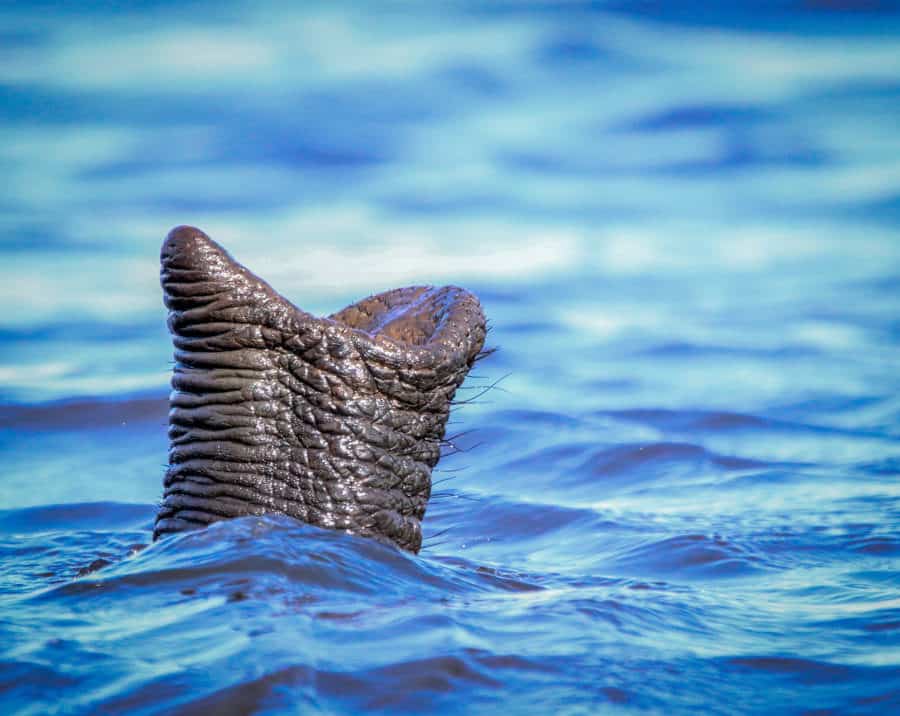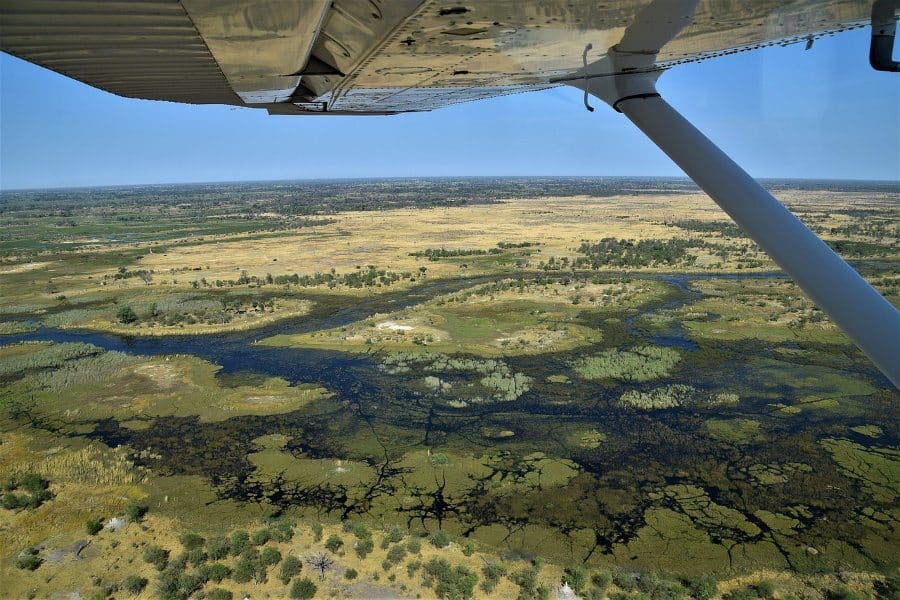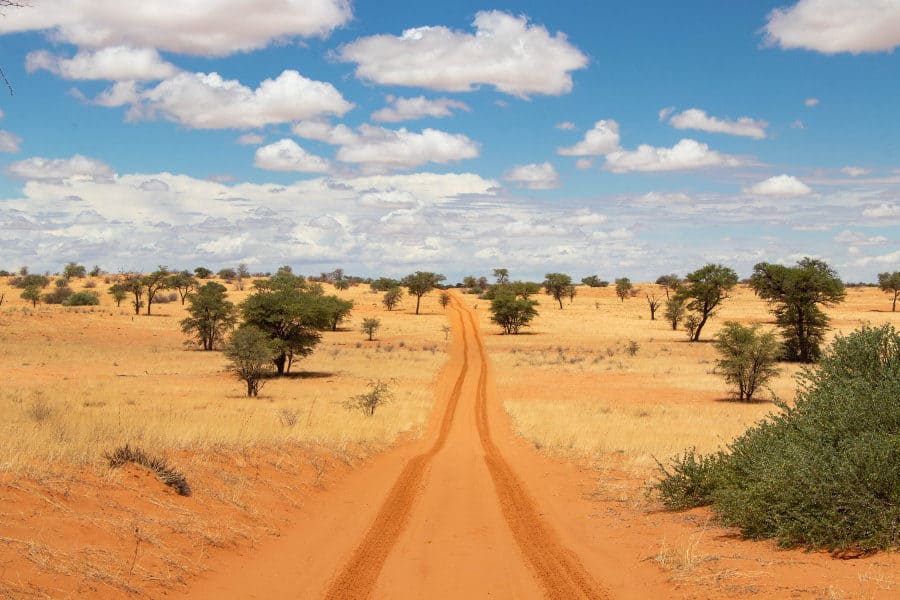Elephants, everywhere. That’s the iconic highlight of a safari in Chobe National Park. And giraffe. Lots of giraffe actually, wandering around in their towers.
Situated in the north of Botswana, Chobe National Park is one of Africa’s most legendary safari destinations. It’s home to the world’s largest elephant population, along with a wonderful variety of other wildlife.
Chobe is also a great destination for a budget safari. The park is easily accessible and highlights as big as elephants are impossible to miss.
This definitive safari guide will immerse you in Chobe National Park and covers all the different visitor options, from super budget day trips to the most evocative of four-day safaris.
Why is Chobe National Park So Special

The abundant and diverse wildlife
Let’s get excited about what you are going to see.
Imagine the sight of an elephant, a giant swinging his trunk and flapping his ears. Now imagine a herd of elephants, perhaps 20 pachyderms barging through the bush. Now try to imagine the sight of 100 elephants. Can you do that?
How about 100,000 elephants? 100,000! That’s how many elephants are in Chobe National Park during the dry season, when resident herds are joined by migratory herds.
Not only is this the world’s largest elephant population, they are the world’s largest elephants. These Kalahari elephants are bigger than those you will see elsewhere in Africa and double the size of Asian elephants. They even dwarf the elephant bulls of Ngorongoro Crater.
Chobe is also one of the best places in Africa to see giraffe. The Angolan giraffe is abundant all over the national park and you cannot miss the world’s tallest animal. Hey – check out all these facts about baby giraffe, the cutest newborn on the savannah!
Then what else? Cape buffalo gather in large herds. Zebra stripes are a common sight. Hippos fill the rivers, grunting and guffawing throughout the day. Crocodiles sunbathe on the banks, causing a stir of commotion when grazers come close.
Baboons cause a racket in the trees while various large antelope species graze around the riverbanks. You can see endangered puku, tsessebe, wildebeest and many more.
Chobe National Park is also the home of predators. This is where you can see lions, leopards, cheetahs, hyenas, and even wild dogs.
So what doesn’t Chobe have? Well, there are no mountain gorillas nor chimpanzees. What else? Hmmm, Chobe has just about all the animals you will want to see on an African safari. The only real exception is the lack of rhinos. Without rhinos Chobe cannot be a big five destination.
A beautiful range of habitats
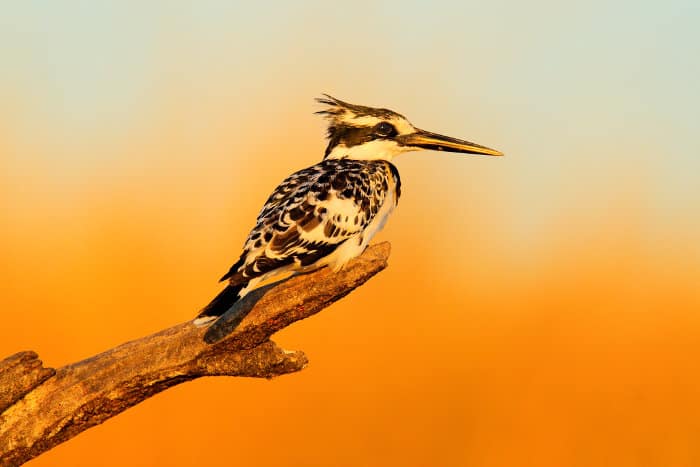
Don’t get too excited just yet. Before you book a flight to Botswana and move permanently to Chobe National Park, you need to understand the habitat, because this has a huge impact on the wildlife viewing experience.
Most of Chobe National Park is dense bush and forest. The vegetation is tall and thick but it’s not all the same. Chobe has four very distinctive ecosystems and these help to attract the wonderful diversity of wildlife.
Thick swathes of teak trees are broken by small lush plains. This is elephant paradise and you can see where herds have bashed new trails in the forest.
The Chobe River meanders along the north of Chobe National Park, forming a natural barrier between Botswana and Namibia. It joins the Kwando and Linyanti, two of Africa’s other most iconic rivers.
Riverine forest dominates the landscape between these rivers, another great habitat for elephants and forest-dwelling antelope.
Elsewhere in the park you will see open woodlands mixed with seasonal swamps and great patches of mud. Again, nice for elephants, as well as being a place where predators can hide.
Animals are attracted to Chobe National Park because there is a lot to eat. They also make a home here because there is so much water. In a Southern African region of arid desert, Chobe provides a haven of fluid bounty.
Vegetation provides places for animals to hide
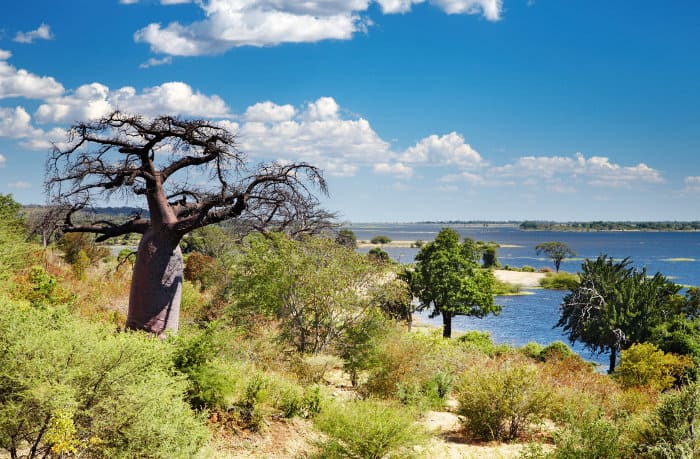
The concentration of lions and leopards in Chobe National Park is as good as anywhere else in Southern Africa. However, not many people will see the big cats because the vegetation is so dense.
It’s easy to encounter predators on open plains, such as Serengeti National Park or the Masai Mara. You enjoy incredible visibility and can hone in on the most famous safari sights.
However, explore Chobe’s dense landscapes and you will not be able to see very far. Trees and bushes block the way. A lion pride may be sleeping just 20 meters from the four-wheel drive trail, but if the lions are completely hidden you will easily miss them.
Giraffe are taller than the trees. Elephants are bigger than the bush. So these animals cannot be missed. But the predators deliberately hide away and it is rare to see them, even though they are so abundant.
Secretive animals like roan antelope can also be difficult to find. While they may be one of Africa’s largest antelope species, it’s easy for them to sneak into the trees and avoid your eyes.
So to recap – Chobe National Park has an incredible wildlife abundance and variety, but the vegetation means you will not encounter it all.
But…just as you cannot see them, the animals cannot see you coming. In dense landscapes like Chobe you can usually get closer to animals than on open grasslands and plains. And getting closer is a wonderful way to connect with your wild side.
A thrilling combination of safari activities

Game drives are the standard activity in most national parks and game reserves. Game walks and nighttime game drives are also an option in private concessions, but rarely in national parks.
Chobe National Park is a wonderful experience because you can combine different activities.
River cruises are integral to every Chobe safari. You can cruise for a few days in a custom boat, down the Chobe River and along its tributaries. Most people do at least a half-day river safari, enjoying all the animals drinking along the banks.
Game drives are also part of the safari, weaving along sandy trails through the forests, to swamps and open grasslands where you look for more than just safari giants.
In some parts of Chobe you can also go on walking safaris, an intimate experience in some of Africa’s wildest areas.
This opportunity to explore in different ways is the biggest highlight of a Chobe National Park safari. You get alternative perspectives and see different animals in different habitats.
Plan a Chobe National Park Safari Around How Much Time You Have
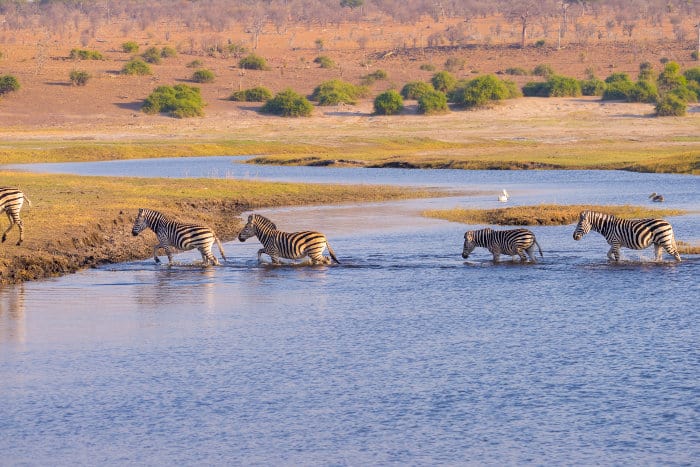
Chobe covers the northeastern corner of Botswana and practically shares a border with Namibia, Zimbabwe and Zambia. You can approach the national park from four different countries! A safari here can even be a day trip from Victoria Falls.
Chobe can roughly be split into four different areas. Each has its own habitat and contrasting animal population.
The key difference is their accessibility. A river runs along the north of Chobe so you can reach some places by water. A highway runs along the eastern boundary and you can spot elephants crossing this road on route to Zimbabwe and other places.
But getting into the heart of an enormous national park will take time. The roads are rough and bumpy. Elephants and buffalo literally block the trails. Plus, you really won’t want to rush.
You need to plan a Chobe safari around how much time you have. This length of time also equates to budget. Although a Chobe National Park is very affordable in comparison to other safari destinations, it’s still not a cheap day out.
Choose the Serondela area for a one-day safari
Serondela in the northeast is less than an hour from the Botswana border with Zambia and Zimbabwe. It’s the most popular area because it’s so accessible by road. Many people visit Serondela on a day or overnight trip from Victoria Falls.
Expect to see lots of elephants, giraffe, buffalo and hippos. Don’t expect to encounter many predators. The vegetation is thick and big cats shy away from the abundance of vehicles in Serondela.
Serondela is the touristic part of Chobe National Park because of all the day trips. You can also stay in affordable lodges overlooking Chobe River, on the Serondela part boundaries.
However if you are going to spend the night it’s better to camp inside the park, so you can also explore the Ngwezumba pans.
With two days try mobile camping and the Ngwezumba pans

The Ngwezumba interior is dry, dense and hot. It’s the heart of the Chobe ecosystem, packed full with surprises and subtle animal behaviour.
The Ngwezumba pans provide water during the dry season so animals don’t need to stick around the rivers. They help to create exceptionally diverse game viewing from July to October.
Wildlife gathers around thick nutritious vegetation and you can get very close to a wide range of Chobe National Park favourites. Expect to see the giants, as well as lesser known species and a small selection of predators.
You need at least two days in Chobe National Park to explore Ngwezumba. Many tour operators run two-day one-night Chobe tours that use basic mobile camps inside the national park.
With three days, immerse yourself in Savute
Forests and grasslands merge together around the Savute Marsh and Savute River, in the far west of the park.
For decades the Savute Channel ran dry. Now the water has returned, along with a stunning abundance of animals.
This is probably Chobe National Park’s ultimate big-game area and you will need three days. Okay, you can do it in two days, but why cut short an African safari?
Open grasslands are great for spotting predators during the dry season. Here you will also encounter large antelope herds. And of course there will be elephants – there are always elephants in Chobe National Park.
Around Savute the national park shares unfenced borders with private concessions. That means your movements will be limited somewhat. However, a safari in Chobe National Park is less than a fifth of the price as a safari in the private concessions.
If you can spend more than USD 500 a day choose Linyanti
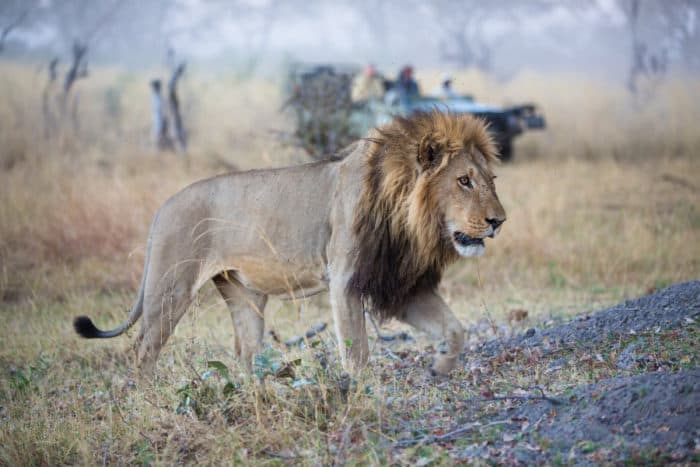
Savute and Linyanti are very similar in habitat, with permanent rivers, woodlands, grasslands and marshes.
Both offer a wonderful variety of habitats, which helps them attract an equally wonderful variety of animals.
In particular, Linyanti is the best place in the Chobe ecosystem to see predators. Lions and leopards are complemented by regular African wild dog sightings. It’s spectacular and it’s really wild, on safari so far from the day-tripping hordes.
If you have three or four days then you can visit Ngwezumba, Savute and Linyanti. However, note that most of the Linyanti area is gazetted as a private concession.
This Linyanti concession joins with Kwando and Selinda, two other phenomenal safari destinations.
These concessions are very expensive but they do offer some of Africa’s ultimate safari experiences.
Planning Where to Stay in Chobe National Park

Lodges on the Chobe River are beautiful, relatively basic, and offer a good safari on a budget. These are the most typical places to stay for a Chobe safari.
You can watch hippos and elephants from the verandah, as well as enjoy Chobe’s superb bird life.
However, these river lodges are not located inside the national park. Whether you go on a game drive or boat safari, you cannot get very far into the park before you need to return to the lodge.
By sleeping inside the park you can travel further and experience more. Mobile camping is very affordable here. It’s more adventurous than the river lodges and can still be comfortable.
Camps move every few days and are pretty basic, with tents, sleeping mats, outdoor bush toilets, and…well, that’s about it. This is camping, not glamping.
But just imagine…you can camp in a national park where 100,000 elephants roam! You can camp in a woodland occupied by big cats and big game. Talk about a connection with your wild side!
When to Visit Chobe National Park

Many Chobe animals are permanent residents. They have all the food and water they need. Except there are two problems.
Chobe National Park isn’t the safest place for many animals, not with so many predators and so many places for these predators to hide. There’s also an issue of overpopulation. Vegetation is depleted with all the mouths that need feeding.
So many of the animals leave Chobe during the green season, which is roughly from late-November to March and April. This is the hottest time of year as well, so it’s not great for being out in the bush, as you can read more about in our detailed Botswana safari guide.
When the rains come the animals spread far and wide. They go off to fresh pastures and vegetation, knowing they can drink from seasonal waterholes and swamps.
November to April is off season so the park will be less crowded. The birdlife is fantastic during these months but you can’t get the complete Chobe big game experience.
After the rains have stopped and the sun has shriveled the earth, Africa’s wildlife returns to Chobe. This is the dry season so there isn’t much water except for in Chobe and the Okavango Delta.
Chobe always has water so it’s an incredibly popular migratory destination, especially for elephants. Animals start arriving from May onward and by July the wildlife population has swelled.
The best time to visit Chobe is June to September, at the height of the dry season, when the vegetation is at its lowest and the animal population is at its highest.
Planning a Safari Itinerary

From the Victoria Falls area
Arrive from Victoria Falls and you will first reach Serondela. By the time you cross the border it will be mid-morning, so not the best time for a game drive.
Most itineraries start with a boat safari along the Chobe River. Then later in the afternoon you can go on a game drive. Spend another day and you can do an early-morning game drive followed by an afternoon boat cruise.
Expect to pay upwards of USD 200 for a Chobe day trip from Vic Falls. Make it USD 300 for an overnight trip – this is really good value for the experience.
From elsewhere in Botswana or from Namibia
Arrive from anywhere in Botswana and you can access Chobe from the south. So it’s best to start with game drives, work your way through the national park, then end with a boat cruise.
Safaris really vary in price and you can find space on a shared safari for USD 150 per day upwards. Expect the price to be much higher for a private safari.
Still, in comparison to the Okavango Delta and elsewhere in Africa, this is good value.
Extended boat cruises

Standard boat cruises are in small boats that go up and down the river past hippos and elephants.
Large live-aboard boats offer multi-day Chobe river safaris. These are ideal if you seek downtime and a very relaxed safari. They travel west towards Linyanti and Savute, so the game viewing is better than a half-day cruise.
These extended Chobe cruises are pretty expensive and start from USD 450 per day.
Extended safaris
Hey, you want to connect with your wild side, right? Well, there aren’t too many national parks wilder than Chobe.
Our advise – try to make your Chobe National Park safari as long as possible.
It takes a long time to even reach the Chobe wilderness, so don’t cut your time short. Immerse yourself and savour the complete Chobe experience.
Right, we’re off to marvel at some elephants in Botswana. Happy safari! 🙂
